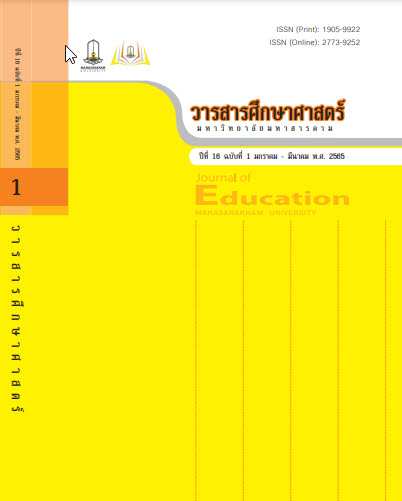The Development of Analytical Thinking Abilities based on STEM Education in Water Cycle for Grade 5 Students
Main Article Content
Abstract
The purpose of this research was to develop grade 5 students’ analytical thinking abilities to meet 70 percent criteria by using STEM education learning approach. The target group included 15 students from grade 5 of Ban Porphan School (Porphanratbumrung), Muang District, Roi Et Province, which conducted in second semester of academic year 2020. The research was used action research design. The research instruments were 1) 3 lesson plans of STEM education learning approach, 2) analytical thinking abilities assessment form, 3) behavior observation form and 4) interview form. The collected data were analyzed using percentage and mean.
The results were as follows: the result of intervention after using STEM education learning approach in water cycle on grade 5 students found that only 4 students met 70 percent of the analytical thinking abilities score criteria, representing 26.67 percent in the
first action research spiral. In the second action research spiral, 6 students met 70 percent of the analytical thinking abilities score criteria, representing 54.55 percent. In the third action research spiral, 5 students met 70 percent of the analytical thinking abilities score criteria, which representing 100 percent of the total number of students.
Downloads
Article Details

This work is licensed under a Creative Commons Attribution-NonCommercial-NoDerivatives 4.0 International License.
References
กระทรวงศึกษาธิการ. (2551). หลักสูตรแกนกลางการศึกษาขั้นพื้นฐานพุทธศักราช 2551. กรุงเทพฯ: กระทรงศึกษาธิการ.
กระทรวงศึกษาธิการ. (2560). มาตรฐานการเรียนรู้และตัวชี้วัดฯ ตามหลักสูตรแกนกลางการศึกษาขั้นพื้นฐาน ฉบับปรับปรุง พ.ศ. 2560. กรุงเทพฯ: กระทรวงศึกษาธิการ.
ฐิติวรดา พลเยี่ยม. (2561). สะเต็มศึกษา: ความเข้าใจเบื้องต้นสู่ห้องเรียนบูรณาการ. วารสารครุพิบูล,5(2), 122-135.
นารีลักษณ์ ศิริวรรณ. (2559). การสอนแบบบูรณาการข้ามกลุ่มสาระวิชา (STEM EDUCATION). [จลสาร]. สถานีวิทยุกระจายเสียงรัฐสภา.
พิชากรณ์ เพ่งพิศ. (2561). ปัจจัยที่มีความสัมพันธ์ต่อทักษะของผู้เรียนในศตวรรษที่ 21 ของนิสิตระดับ ปริญญาตรี มหาวิทยาลัยเกษตรศาสตร์ วิทยาเขตกำ แพงแสน. วารสารศึกษาศาสตร์มหาวิทยาลัยศิลปากร, 18(1), 319-338.
โรงเรียนบ้านปอภาร (ปอภารราษฎร์บำรุง). (2563). รายงานการประเมินตนเองของสถานศึกษาปีการศึกษา 2563. ร้อยเอ็ด: โรงเรียนบ้านปอภาร (ปอภารราษฎร์บำรุง).
สถาบันส่งเสริมการสอนวิทยาศาสตร์และเทคโนโลยี. (2558). สะเต็มศึกษา (STEM Education). กรุงเทพฯ: สถาบันส่งเสริมการสอนวิทยาศาสตร์และเทคโนโลยี (สสวท.).
สิรินภา กิจเกื้อกูล. (2558). สะเต็มศึกษา STEM Education. วารสารศึกษาศาสตร์ มหาวิทยาลัยนเรศวร, 17(2), 201-207.
สุนิสา บางวิเศษ. (2562). การพัฒนาการคิดวิเคราะห์ ของนักเรียนชั้นประถมศึกษาปีที่ 5 ที่ได้รับการจัดการเรียนรู้ตามแนวทางสะเต็มศึกษา. วิทยานิพนธ์การศึกษามหาบัณฑิต (หลักสูตรและการสอน), มหาวิทยาลัยมหาสารคาม, มหาสารคาม.
เสกสรร สรรสรพิสุทธิ์. (2560). เสวนาวิชาการสะเต็มศึกษา: เรียนรู้เพื่อแก้ปัญหาพัฒนานวัตกรรมนำสู่อาชีพ. สืบค้นเมื่อวันที่ 20 พฤศจิกายน 2563, จาก http://www.stemdthailand.org/
Susoarat, P. (2013). The development of thinking. edition, Bangkok: Printing.
Bloom, B.A. (1956a). Taxonomy of education objective handbook I: Cognitive Domain. New York: David Mc Kay Company


